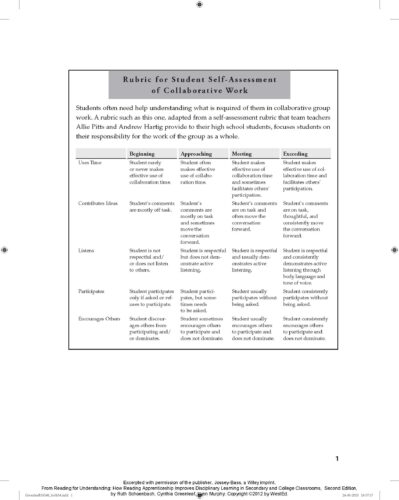Students often need help understanding what is required of them in collaborative group work. A rubric such as this one, adapted from a self-assessment rubric that team teachers Allie Pitts and Andrew Hartig provide their high school students, focuses students on their responsibility for the work of the group as a whole.
Student Learning Goals: Mathematics
Student Learning Goals let students in on all the ways they can expect their reading and learning to grow in a Reading Apprenticeship classroom. They also allow the teacher and students to monitor growth.
The learning goals are organized in sets that parallel the Reading Apprenticeship framework: social dimension, personal dimension, metacognitive conversation, cognitive dimension, and knowledge-building dimension. In each subject area, the set of goals is the same in the social and personal dimensions and for metacognitive conversation.
The learning goals vary somewhat by subject area in the cognitive dimension and are entirely discipline-specific in the knowledge dimension. This resource provides Student Learning Goals for mathematics.
Student Learning Goals: Literature
Student Learning Goals let students in on all the ways they can expect their reading and learning to grow in a Reading Apprenticeship classroom. They also allow the teacher and students to monitor growth. The learning goals are organized in sets that parallel the Reading Apprenticeship framework: social dimension, personal dimension, metacognitive conversation, cognitive dimension, and knowledge-building dimension. In each subject area, the set of goals is the same in the social and personal dimensions and for metacognitive conversation.
The learning goals vary somewhat by subject area in the cognitive dimension and are entirely discipline-specific in the knowledge dimension. This resource provides Student Learning Goals for literature.
Student Learning Goals: History
Student Learning Goals let students in on all the ways they can expect their reading and learning to grow in a Reading Apprenticeship classroom. They also allow the teacher and students to monitor growth.
The learning goals are organized in sets that parallel the Reading Apprenticeship framework: social dimension, personal dimension, metacognitive conversation, cognitive dimension, and knowledge-building dimension. In each subject area, the set of goals is the same in the social and personal dimensions and for metacognitive conversation.
The learning goals vary somewhat by subject area in the cognitive dimension and are entirely discipline-specific in the knowledge dimension. This resource provides Student Learning Goals for history.
Student Learning Goals: Science
Student Learning Goals let students in on all the ways they can expect their reading and learning to grow in a Reading Apprenticeship classroom. They also allow the teacher and students to monitor growth.
The learning goals are organized in sets that parallel the Reading Apprenticeship framework: social dimension, personal dimension, metacognitive conversation, cognitive dimension, and knowledge-building dimension. In each subject area, the set of goals is the same in the social and personal dimensions and for metacognitive conversation.
The learning goals vary somewhat by subject area in the cognitive dimension and are entirely discipline-specific in the knowledge dimension. This resource provides Student Learning Goals for science.
Clarification Chart
A clarification chart helps students focus on where they lose comprehension in a text and what they can do about it. This graphic organizer suggests that reading is not magical, but rather a process of solving problems. The reader is in charge—of identifying roadblocks or confusions, trying problem-solving strategies, and taking a best guess at what the difficult passage may mean. For the teacher, the chart reveals where students struggle and what strategies they have appropriated for taking control of their reading. As students gain control and become increasingly metacognitive, the use of the chart should fade.
This PDF consists of two pages, with two versions of the chart: one page that includes context for teachers, and one that is blank for student use.

